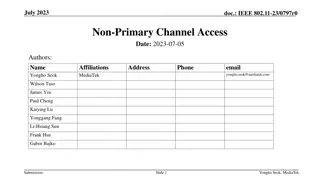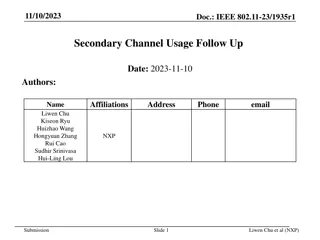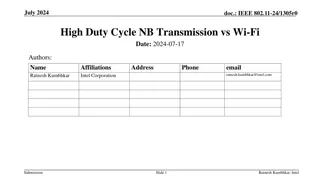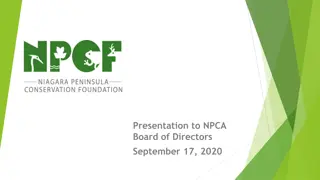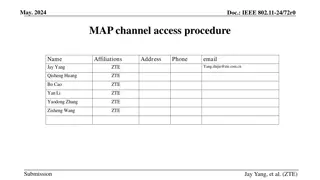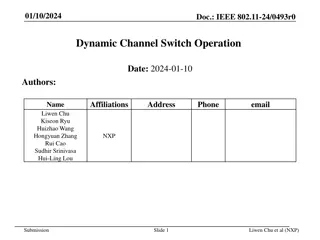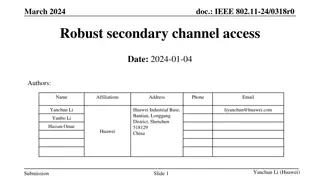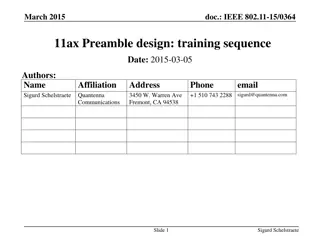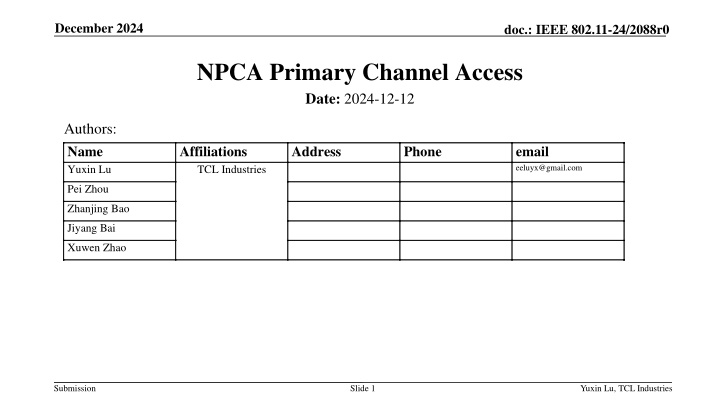
Optimizing NPCA Channel Access: Proposed Solutions and Modes
Explore the IEEE 802.11-24/2088r0 document discussing the non-primary channel access (NPCA) mode, enabling STAs to access secondary channels when the primary channel is busy. The proposed solutions include trigger-only mode and contention-enable mode, enhancing channel access efficiencies and opportunities for AP and non-AP devices. Learn about the advantages of these modes and the potential for restricted contention-enable mode for improved contention in accessing NPCA primary channels.
Download Presentation

Please find below an Image/Link to download the presentation.
The content on the website is provided AS IS for your information and personal use only. It may not be sold, licensed, or shared on other websites without obtaining consent from the author. If you encounter any issues during the download, it is possible that the publisher has removed the file from their server.
You are allowed to download the files provided on this website for personal or commercial use, subject to the condition that they are used lawfully. All files are the property of their respective owners.
The content on the website is provided AS IS for your information and personal use only. It may not be sold, licensed, or shared on other websites without obtaining consent from the author.
E N D
Presentation Transcript
December 2024 doc.: IEEE 802.11-24/2088r0 NPCA Primary Channel Access Date: 2024-12-12 Authors: Name Yuxin Lu Affiliations TCL Industries Address Phone email eeluyx@gmail.com Pei Zhou Zhanjing Bao Jiyang Bai Xuwen Zhao Submission Slide 1 Yuxin Lu, TCL Industries
December 2024 doc.: IEEE 802.11-24/2088r0 Introduction According to SFD [1], TGbn has agreed to define a non-primary channel access (NPCA) mode that enables a STA to access the secondary channel while the primary channel is known to be busy due to OBSS traffic or other TBD conditions. A BSS shall only have a single NPCA primary channel In this proposal, we discuss how to access NPCA primary channel (PCH) Submission Slide 2 Yuxin Lu, TCL Industries
December 2024 doc.: IEEE 802.11-24/2088r0 Background Many contributions have discussed the switching then access procedure; ideally, AP and non-AP STAs switch to NPCA PCH synchronously/simultaneously See references in [Sec 3.4 Non-primary channel access, 1] and [2] A potential approach is to enable only AP triggered transmission in accessing NPCA PCH (trigger-only mode) Motion #129 TGbn defines a mode of operation in NPCA where the NPCA non-AP does not use untriggered UL transmissions on the NPCA primary channel [1] This mode can be enabled/disabled by the AP Whether the mode is for all associated non-APs or per non-AP is TBD TBD whether MU EDCA parameters mechanism is used for this or not Submission Slide 3 Yuxin Lu, TCL Industries
December 2024 doc.: IEEE 802.11-24/2088r0 Proposed Solution 1 Enable Trigger-only Mode & Contention-enable Mode However, with trigger-only mode Non-AP STAs passively lose the opportunity for channel contention after switching especially for those that have the capability to maintain medium synchronization in NPCA PCH As such, it would be more beneficial to consider both trigger-only mode and contention- enable mode for accessing NPCA PCH AP signals access mode, trigger-only mode or contention-enable mode, which include Trigger-only mode: enable only AP triggered transmission in accessing NPCA PCH Contention-enable mode: both AP and non-AP can initiate contention and obtain transmission opportunity in accessing NPCA PCH Besides, we may define another restricted contention-enable mode, see next page Submission Slide 4 Yuxin Lu, TCL Industries
December 2024 doc.: IEEE 802.11-24/2088r0 Proposed Solution 1 - ctnd Enable Restricted Contention-enable Mode AP Non-AP What is a restricted contention-enable mode for NPCA? Let non-AP use EDCA to access NPCA PCH, improve overall possibility to win contention Mandate non-AP to share wireless resources to AP on NPCA PCH non-AP may signal its traffic status (BSR or TID) for AP s consideration AP may choose whether to reply/accept depending on its capability (whether can reply on NPCA PCH) and channel state AP may perform BW extension to find more available channels after being shared A special case: PCH is idle on AP side, then PCH can potential also be utilized Switch to NPCA PCH, complete backoff Non-AP establishes TXOP on NPCA PCH ( (Optional) ) TXS or RDG with the following benefits Let non-AP keep the opportunity for channel contention in accessing NPCA PCH Take the advantage of AP triggered transmission in enabling synchronous switching Confirm TXS or RDG on NPCA PCH Triggered UL or DL; Perform bw extension optionlly Submission Slide 5 Yuxin Lu, TCL Industries
December 2024 doc.: IEEE 802.11-24/2088r0 Proposed Solution 2 Improvement for Triggered Access Improvement 1: AP signals a Maximum acceptable switch time Considering switch time for some non-AP STAs may be too long to access a certain NPCA PCH, especially when beyond its operating bw AP can have control over the Maximum acceptable switch time to improve access efficiency for performing NPCA Non-AP signals a Preferred NPCA duration/ending time It can choose to keep staying on NPCA PCH after this NPCA occurrence ends, to avoid frequently switching back and forth It can choose to stay on NPCA PCH for DSO without switching back It can change its choice for each NPCA occurrence by updating this time value AP Non-AP Maximum acceptable switch time Switch to NPCA PCH, complete backoff Triggered UL or DL on NPCA PCH, indicating NPCA duration/ending time Preferred NPCA duration/ending time Submission Slide 6 Yuxin Lu, TCL Industries
December 2024 doc.: IEEE 802.11-24/2088r0 Proposed Solution 3 MAP-assisted Access NPCA coordination negotiation: signal location of PCH & NPCA PCH, switch delay Scenario: AP2 discovers its PCH2 is often busy caused by AP1 s transmission, then AP2 initiates NPCA coordination negotiation with AP1 When AP1 starts tx, it shares certain BW or time resource for AP2, with padding if needed; indicate this frame is used for NPCA switch signaling Scenario: AP2 s PCH2 is within the tx /operating BW of AP1 The same BW can be allocated to non-AP STA in BSS1 after AP2 is done using AP 1 AP 2 NPCA coordination negotiation Share bw or time resource Perform NPCA within BSS Trigger Usage = NPCA switch signaling RU Allocation = Shared BW Allocation Duration = Shared time TA = AP1 RA = Broadcast AID 12 = AP2 ID AID 12 = non-AP MAC header User Info field #1 User Info field #2 Example: Trigger frame Submission Slide 7 Yuxin Lu, TCL Industries
December 2024 doc.: IEEE 802.11-24/2088r0 Proposed Solution 3 - ctnd MAP-assisted Access For AP2, corresponding actions can be below If shared BW includes PCH2, then signal on PCH2 to non-AP STAs to switch to NPCA PCH2 If shared BW includes NPCA PCH2 but not PCH2, then switch to NPCA PCH2 immediately and perform channel access; it may not need to perform backoff if BW and time has been shared If shared BW includes both PCH2 and NPCA PCH2 , then signal on PCH2 to non-AP STAs to switch to NPCA PCH2; it may not need to perform backoff after switching to NPCA PCH2 if BW and time has been shared AP 1 AP 2 NPCA coordination negotiation Share bw or time resource Perform NPCA within BSS Submission Slide 8 Yuxin Lu, TCL Industries
December 2024 doc.: IEEE 802.11-24/2088r0 Summary In this contribution, we discussed how to access NPCA PCH and corresponding solutions Solution 1: Enable trigger-only access mode & contention-enable access mode Solution 2: Improvement for triggered access Solution 3: MAP-assisted access Submission Slide 9 Yuxin Lu, TCL Industries
December 2024 doc.: IEEE 802.11-24/2088r0 Straw Poll 1 Do you agree to define a mode in NPCA where the non-AP can access NPCA primary channel after switching under TBD conditions? NOTE Whether to mandate the non-AP to share wireless resources to AP on NPCA PCH is TBD Submission Slide 10 Yuxin Lu, TCL Industries
December 2024 doc.: IEEE 802.11-24/2088r0 Straw Poll 2 Do you agree that the AP may signal a maximum acceptable switch time in NPCA? NOTE Considering the switch time for some non-AP STAs may be too long to access a certain NPCA PCH, degrading the overall access efficiency for performing NPCA Submission Slide 11 Yuxin Lu, TCL Industries
December 2024 doc.: IEEE 802.11-24/2088r0 Straw Poll 3 Do you agree that the non-AP may signal a preferred NPCA duration/ending time when responding on the NPCA primary channel? Submission Slide 12 Yuxin Lu, TCL Industries
December 2024 doc.: IEEE 802.11-24/2088r0 Straw Poll 4 Do you agree to introduce NPCA coordination negotiation between APs? NOTE The detailed signaling procedure is TBD Submission Slide 13 Yuxin Lu, TCL Industries
December 2024 doc.: IEEE 802.11-24/2088r0 References 1. 2. 11-24/209r6, Specification Framework for TGbn 11-23-2005-01-00bn-non-primary-channel-access-npca Submission Slide 14 Yuxin Lu, TCL Industries



